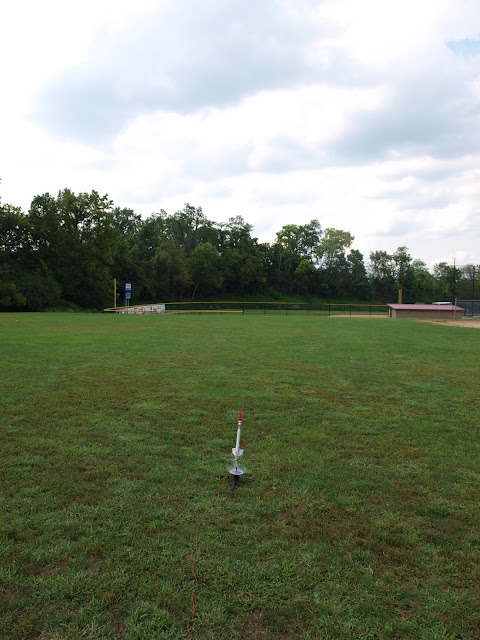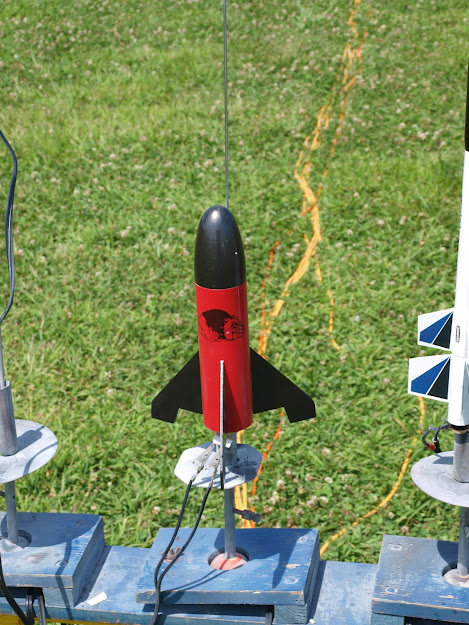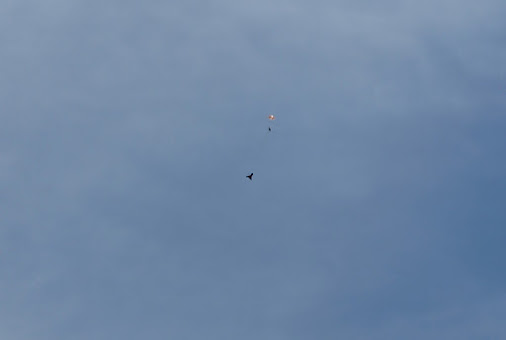Being as how this was looking for all the world like the perfect August weekend, I decided that I'd find time to fly at some point, assuming that the fields were not being used for a team sport of some kind. Friday night football called, and Saturday I got talked into the pool with my wife, but today everything fell into place, and at 4:00 I found B6-4 Field empty even of geese. A box of first flight birds accompanied me, so they wouldn't have lasted long anyway. They hate the sound of a rocket launch.
Flight #1 of 14 on the day would be the Estes Battle Damage X-Wing that I attempted to fly here the last time the field surfaced.
In the time since the last "flight" I did some work on the BDXW that I hoped would result in the kind of flight that would make Luke and R2 proud. No, that's not true. This thing was such a junker that a straight up and down nosedive into the infield playa would have worked for me. But how often do I get to fly a C6-3 at B6-4 Field, eh?
Liftoff looked great, but trouble reared its ugly head early when I heard the distinctive sound of skywriting before I could even drop the launcher. In the second picture above you can already see signs of trouble as it began to swap ends before the 20 foot mark. Last time I got a pretty cool shot of the rocket in distress.
This time I wasn't as lucky with the clarity, but I still got the picture that pretty much tells the story of the flight.
Got more altitude this time. Won't be a next time. I didn't get the satisfaction of seeing it nose into the hard packed infield as the whole flight took place over the outfield and the chute fired about fifteen feet from thud recovery. Nonetheless, I won't waste another C6-3 on this bird.
I always make sure I pack along a Semroc bird or two for these small field excursions. Today it was two, the first being the Cherokee C that I finished last night.
This was the culmination of a multi-year project. The Cherokee C had been plagued by paint issues that took forever to work out, then a spill that soaked the decal sheet last week, just when it looked like I was going to get those last three decals on. I cleaned up the water and almost tossed the remaining decals, but I set them aside and forgot about them until last night. I expected to find them ruined, but they still had the gloss on them, so I decided to give them a try. They worked flawlessly, and the rocket looks great. The Cherokee C is a small bird for B6-4 Field, so experience and the hanging rocket collection told me to load an A8-3 for the first flight.
The A8-3 was a perfect choice. Flight was high and straight. What breeze there was had pretty much died off before I punched the button and after ejecting at apogee, the Cherokee C landed on the hill just below the trees.
Flight three was another redemption flight, the Estes Star Wars Darth Vader Tie Fighter. This flew about a year ago and rekitted itself after a hard landing. Turns out the force of the thrust at takeoff had cracked the rather tenuous glued joint near where the probe fit into the Fighter. I reglued it more securely and decided to give it another go.
Much like its Star Wars brother ship, this one began skywriting before my camera burst mode finished. Also like the X-Wing, it looked to be still under thrust with the nose in a downward pointing position. This could get good.
Unfortunately the whole hot mess was saved when the chute filled with about five feet to spare. Pity. Might have been an interesting crash scene.
Next up was my recently finished BT-50 Estes Wizard clone on an A8-3. I expected a lot out of this flight, as rockets of this size have historically flown well on A8-3s. (By flown well I mean that they fly to a respectable altitude and don't wind up in trees.)
This one was no exception. It flew well. It attained a respectable altitude. It stayed out of the trees. It made me happy, even with the iffy recovery.
No rockets were harmed in the making of this parawad recovery shot.
Flight #5 would be a daring undertaking, my FRW Miniscule Max on a 1/4A3-3T. Daring because as anyone who has ever flown an Estes Mosquito knows, chances of recovery, even with the 1/4A, are a coin toss at best.
Since this bird was slightly longer than the Mosquito, I used the extra length to install a motor block and a minimal recovery system. It's a tight fit, but I figured it would greatly increase the distance that the rocket would be flung after one of the possible Estes nuclear ejection charges.
Rarity of rarities, I actually got something of a launch shot. Even better, this pack of 1/4As had an ejection charge more befitting the mini motor. Even if I hadn't gone with the nose blow recovery I think there was a decent chance of getting this one back. I saw the whole flight. Wish they stocked these at Hobby Lobby. I still have one of the motors left from the pack, so it's earmarked for the Mosquito. Believe it or not, I've never flown a Mosquito, and hadn't even built one until a year or two ago.
In keeping with the nose blow theme, flight #6 was the Custom Metrix, a vintage bird from the early days of Custom Rockets on a 1/2A3-4T.
This one will eventually be painted with the last of my Rustoleum Midnight Black Metallic paint because it will look cool and there will be no need for masking, which the paint seems to have issues with. For now it's just in primer, but it qualified for flight today due to it never having flown before.
Altitude-wise, the flight was very similar to the Miniscule Max, but a lot easier to see due to the extra length. The Mylar streamer failed to stream, but all ended well as the rocket is very light and floated sideways nicely. Looking forward now to getting it painted and finding the decal. Uh, yeah, the decal. Wish I knew where I saw that last......
I always like flying the Ebay orphans, this hippy-dip HoJo being no exception. Not much to look at, but it's solid and was easy to put back into flight trim. I like this one for the "whatever color paint was in the garage" paint scheme.
Though peculiar looking, I was impressed with how this one flew. Very good altitude and dead straight, which didn't happen a lot on the day.
After the "slow, realistic liftoff", (which is noticeable by the fact that I got four shots with my very slow SLR,) things got a bit tense. It was quite high at ejection, and it immediately began floating toward the trees near US 27. After an initial panic, it cleared them easily, but then it had to deal with the road, and the fact that I was wearing flip flops and was walking like a duck. It had looked to me to have landed in the road, but in actuality it missed by four feet or more.
No damage despite the asphalt recovery. Not all my flights would be so lucky.
Flight #8 was another unfinished bird that has been sitting around since it was a Wal-Mart exclusive back in 2009, the Estes Crossbow SST.
I loved the Satellite Interceptor lines of this one, but the odd fin setup kind of set me off, which is why it sat around not even in primer for six years. I recently got a bug about finishing unfinished projects, and this was one that was unearthed. No plans to leave it as it is. I miss the wingtip tubes and have some 10.5mm tubing left over, so it will wind up looking a lot more like the S.I. by the time I'm finished.
A8-3 flight, which is a lot of motor for a little bit of rocket in this case. I considered turning this one into a 13mm bird, but never followed through on the idea. Great flight, high and straight, but looked to be in trouble immediately upon ejecting. During the last fifty feet of the fall to earth it seemed to be in constant peril, barely missing the outstretched limbs of the RETs hungry for cardboard and balsa.
All I could do was shake my head. Some days you just live lucky. Not very often for me, so I tend to enjoy them when they happen.
Ninth flight of the day was the second Semroc bird in the box, the Swift. This was a rarity on the day in that it was fully finished, but still unflown. I picked this one up a few years back because it was an original Semroc bird from the early days of the comany, and as such, a Carl McLawhorn design.
In my mind this one looked different than how it turned out. The nose cone is the standard 2015 Midnight Black Metallic, while the fin can is a Black Cherry Pearl that I've had sitting around for a long time. Not much cherry in it. Decals are a home brew inkjet mashup that probably should have been bigger. Ah, well. I still like the old school lines.
Very respectable altitude with recovery near the RETs. Never in trouble, though. I love solid little beginners kits like this one.
Flight #10 was a rocket that was previously flown, but back in 2004, so I felt like I could make another exception. Papa Blink was the patriarch of the Blink Family, a three rocket combo pack from Rockethead Rockets. I liked them because they reminded me of the Estes Javelin/Super Flea combo, which was the first rocket of one of the other guys I started with in the neighborhood.
All of the family, Papa, Mama and Baby, flew back in 2004, but Baby disappeared on a 1/4A at VOA. Saw nothing. Heard nothing. Mama had a great flight and recovery, but Papa had a rough landing after his 1/4A flight. He landed over near the access road, and I'm pretty sure he was stepped on before I could get to the landing site. He also had a bit of a whang on the top of the body tube from the nose cone rebound. Whatever the case, major head trauma. He and Mama showed up this summer while I was cleaning in the shop on a rainy vacation day, and today seemed like a good chance to get them back into the air in memory of Baby. Mama would have flown as well, but I found her missing a fin at the bottom of the box when I arrived at the field, so Papa got to go solo on a 1/2A. That may have been a bit too much motor. I saw the flight, saw the tracking smoke, and even followed him down for a second or two, but then I lost him. I started scanning the field in the area in front of the trees, which seemed to be the most likely safe landing spot for him, but saw nothing. I did hear something, an ever so faint something that suggested a minimum diameter rocket going into the trees. I walked up to the road and scoured the field, but found nary a sign of him. Hopefully he and Baby can look each other up.
Flight #11 was the Estes Fox Fire that was another of my long-term clones. It's been around for as long as we've lived in our current house and still has yet to see primer.
The inspiration for this rocket was finding the oddball nose cone that came as a part of my first Estes Designers Special. My enthusiasm waned when the decal printed out strangely large, but it showed up during the finishing blitz, and got the recovery system it needed for a first flight. That finishing part has still eluded me, though.
This was the ultimate luck flight of the day. I thought I'd picked up some spectators over in the baseball dugout, but they turned out to be Geocachers. The A8-3 was quite a bit of motor for this bird, especially on this field. The Fox Fire easily topped the trees, then seemed to chase its tail across the field after ejection. It reminded me of the first Centuri Scram Jet that I treed here in 2001. The large rear fins just seemed to steer it into trouble, and the same thing looked to be happening in this situation. It landed over behind the backstop, just missing the trees, the fence, the water fountain and the wires. The kid gathered it up and brought it to me and we talked Geocaching for a few minutes. I pointed them toward a couple that I bothered with when I first got my GPS, and they promised to yell if they found the one at the field. By the time I got back to prep Flight #12, they were gone.
Flight #12 was another seldom seen mini-engine bird, the Estes Pulsar. I got the decal as one of several in an Ebay lot many years back, and always meant to actually build the rockets they came from. I think the Spin Fin, Echo and Eclipse also came from that lot and eventually got built, but the Pulsar is now a part of the fleet as well.
The camera was cranky, so this is all for pics of the Pulsar. Great flight on a 1/4A, high enough to count as a flight and nowhere close to overflying the field. Recovered in the grass and if not for the two Star Wars birds would have been closest to the pad on the day.
Lucky #13 would be another 1/4A flight, a vintage Custom Sunracer. I've had this one flyable for quite a while, but after the fire & forget performance from the Estes 220 Swift a few years back, I've been more than a little leery of flying it.
Ironic that the two Custom birds that I picked to fly were both built using the same nose cone. It's not much from a fit and finish perspective, but it's unique. As expected, it got off the pad quickly, but the 1/4A3-3T motor kept it in sight through the whole flight.
At ejection I started walking over to the spot where I thought it would most likely fall. I chose well. As I was looking at the spot the motor casing landed 20 feet in front of me right where I'd been looking. I laughed, and apparently blinked because when I looked again the Sunracer was there next to the casing, about four feet away from the fin that came loose at ejection.
Nice grouping, eh? It was a clean break and will be an easy fix. Now I need to lay in a supply of 1/4A motors. I still have a Mosquito, a Quark, another 220 Swift and a Rogue Aerospace Gnat that need flight time.
I almost quit at lucky 13, but I decided to push my luck with my newly finished Estes Wizard on an A8-3. I've owned a bunch of Wizards since the first one in 1978 and have yet to paint one in the new color scheme.
This particular one is an original that I bought from the same guy that I got the two from that arrived today. All Ebay buys. I've built two out of the stash in the past year. The first one broke broke a fin at ejection. This one broke a fin on landing. The A8-3 almost puts it out of sight, but I did see the tracking smoke, so I followed the breeze out to where I thought it might have landed. I picked well again. It was sitting just out of the roadway on the asphalt, right next to the shattered fin that broke when it hit.
I love my Wizards, but I sure don't have much luck with them.


































































